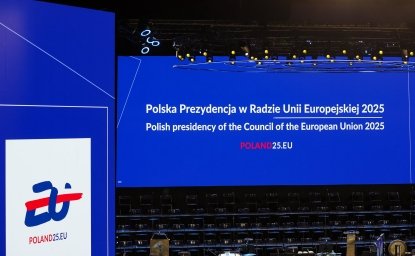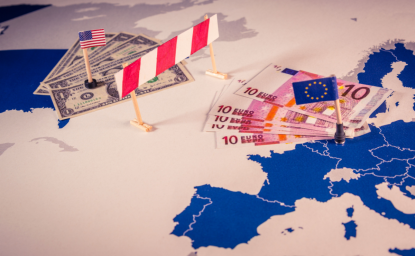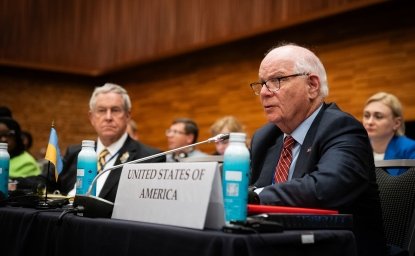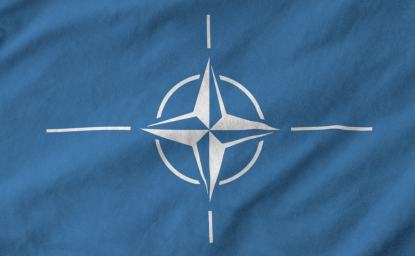333. Compromising Memory: The Site of the Sarajevo Assassination

Paul B. Miller is Associate Professor of History, International University of Sarajevo and McDaniel College. He spoke at an EES Noon Discussion on January 10, 2007. The following is a summary of his presentation. Meeting Report 333.
When Serbian artillery began pounding Sarajevo in spring 1992, Bosnian Muslims struck back by destroying a potent symbol of Serb nationalism: the footprints marking the exact spot Gavrilo Princip stood when he shot dead Archduke Franz Ferdinand, heir to the throne of the Austro-Hungarian Empire. The infamous June 28, 1914 assassination aimed to remove Austria-Hungary from Bosnia and Herzegovina, and thus clear the way for a unified Yugoslav (South Slav) state. Yet the consequences were far more than Princip and his co-conspirators had bargained for: this event became the euphemistic "spark that lit the fuse," igniting the First World War. Yugoslavia, with the help of the Great Powers, was indeed born out of that war, and so too was the short, but troubled twentieth century.
Princip's footprints had been embedded into the concrete sidewalk by the government of post-World War II communist Yugoslavia, which exalted the assassin far more than the unstable interwar state. They soon became one of Sarajevo's main tourist attractions, photographed by thousands of visitors, typically with someone standing directly in the footprints, posing like the assassin. All these acts—creating, promoting and destroying Princip's footprints, not to mention re-enacting the murder itself—constitute just some of nearly a century's worth of interpretations, commemorations, representations and manipulations of the Sarajevo assassination. Indeed, from the moment news of the Archduke's death got out, the struggle over its meaning began. This struggle continues to this day in a number of different social, political and cultural contexts.
As part of a larger book project on the shaping of memory of the Sarajevo assassination, I focus on the shifting memorial landscape at the murder site. While the various monuments, memorials and museums that have adorned the street corner where Princip fired his famous shots can be telling in terms of how independent Yugoslavs have struggled to understand the assassination as part of their national history, the memorialization process, as we shall see, has rarely broken free from outside influence. For many Westerners, the Sarajevo assassination merely confirms their stereotypes of Balkan backwardness and barbarism, and thus has provided a convenient means to divert blame for the First World War from their own leaders. For many South Slavs, however, June 28, 1914, will always be the beginning of their liberation from centuries of foreign control. Moreover, while the assassination is as inseparable from the city in which it took place as the House of the Wannsee Conference is from Berlin, how Sarajevans and Yugoslavs generally have sought to live with this history is a more complicated matter. For although an event as scrutinized as the Holocaust in terms of memory and identity is in little danger of being glorified in official representations, the Sarajevo assassination has always been looked upon more ambivalently by those who must accept it as their own.
One of the earliest illustrations of this contradictory past is the first memorial marking the assassination site—the Spomenik umorstvu, or monument to murder. Placed at the entrance to what would later be known as Princip's bridge, this mammoth, late Secession monument to the murdered heir and his wife was nearly as provocative as Ferdinand's open-air car ride through Sarajevo on the Serbian Orthodox holiday of Vidovdan. Three years into the war, with the Serb army on the run, the Austrians may have been feeling overconfident when they dedicated it, in a Catholic religious ceremony, on June 28, 1917.
Yet clearly they had learned nothing about the people they ruled. The monument was taken down almost as soon as the Kingdom of Serbs, Croats and Slovenes took over in late 1918. Then, following a stint in the State Museum, it was broken up—one of the ten-meter columns going to a stonecutter in Trebinje, the other to a quarry in Sarajevo. Apparently they were used to pay the long overdue bill of the miners who had excavated the monument's stone. As for the massive central medallion engraved with the images of Ferdinand and Sophie, it has spent the last 60 years collecting dust and a thick layer of patina in the basement of Sarajevo's Art Gallery. Given the fate of the monument, it would seem that Bosnia and Herzegovina and its capital Sarajevo were, at last, truly free from foreign oppression.
Or were they? While the neglect of a monument to Bosnia's occupiers is hardly a revelation, the same cannot be said for the way in which the leaders of the Kingdom of Yugoslavia sought to moderate attempts to glorify the event that, arguably, led to the country's conception. It took more than 11 years before they decided upon, or at the very least permitted, a memorial at the assassination site—a simple, black plaque placed high above the street that announced, rather tamely: "Princip proclaimed freedom on Vidovdan 15 (28) June 1914." Then, just three days before its dedication on February 2, 1930, according to a London Times correspondent in Belgrade, the plaque's provenance was revised. A seemingly uneasy Yugoslavia, likely due in part to its growing reliance on Western aid during the Depression, suddenly announced that Princip's family and friends had created the tablet and not Narodna Odbrana, a society with government ties that Austria had implicated in the assassination. State authorities also issued a statement to the effect that they were powerless to interfere with this wholly private initiative.
Winston Churchill deemed the act of memorializing the assassination an "infamy." The Deutsche Allgemeine Zeitung called it "a monstrous provocation which cannot be suffered," and dismissed the absence of government officials at the dedication ceremony as a "trivial distinction." The British historian and staunch Yugoslav supporter Dr. R. W. Seton-Watson went further, accusing the government of hypocrisy for pretending it could not prevent the public commemoration. For most Western commentators in 1930, the Archduke's murder remained, as the London Times editorialized, "an act which was the immediate cause of the Great War, of its attendant horrors, and of the general suffering which has been its sequel." Any monument to it was unacceptable.
Yet, despite Western accusations of "indifference to foreign public opinion," the Kingdom of Yugoslavia did seem to make serious efforts to appease the West by dampening the impact of the memorial and its unveiling ceremony. What Rebecca West later described as a "modest" tablet engraved with words that were "remarkable in their restraint," was not only unveiled without a single government official on hand, but a ceremony at the National University that was to feature several speakers and the participation of cultural, humanistic and patriotic groups was cancelled at the last minute. In fact the date of the ceremony itself, the program of which was buried on page 5 of Sarajevo's Vecernja PoŠta, could only have been intended to further muffle the international outcry. February 2, 1930, was the 15th anniversary of the execution of three men involved in the assassination plot—Danilo Ilic, MiŠko Jovanovic and Veljko Cubrilovic. It was a date, in short, rather arbitrary even for Sarajevans. It is therefore no surprise, but more than a little revealing, that the London Times mistakenly reported it as the 50th anniversary of Princip's death.
The 1930 unveiling was indeed "subdued and without special ceremony," exactly as the Vecernja PoŠta had announced it would be two days earlier. Even the Belgrade press reined in any enthusiasm by stating, blandly, that the plaque was a tribute to the memory of those who had risked their lives for the Fatherland. The first opportunity for the newly independent Yugoslavia to commemorate the Sarajevo assassination found the site transformed into a World War I memorial. Perhaps there was not so much freedom to celebrate after all.
The Nazis and Ustasha were, unsurprisingly, hardly fooled by these official attempts to underplay the assassination in the construction of Yugoslav national identity. With their own sense of ceremony, the Nazis removed the plaque in the first days of their occupation of Sarajevo in April 1941. A few weeks later, it was presented to Adolf Hitler for his 52nd birthday. "Sarajvo has cleansed itself of the Vidovdan stain," exulted an NDH article in Sarajevski Novi List that July. The official Nazi newspaper, the Völkischer Beobachter, went so far as to depict Princip and his collaborators as Jews and Freemasons. Accordingly, it was now the so-called Jewish menace that had long denied South Slavs their true freedom.
In the rhetoric and mythologizing of the communist Partisans who liberated Sarajevo, 1945 became the fulfillment of everything that 1914 had stood for: the struggle and courageous self-sacrifice of Bosnia's youth for justice and freedom; the liberation from the Germanic oppressor; the awakening of a revolutionary consciousness; and the spirit of brotherhood and unity embodied in the mixed ethno-religious backgrounds of the Young Bosnians and Partisans alike. If the first Yugoslavia was "a dungeon…where the people of Bosnia and Herzegovina had no rights," then now the dream was finally coming true, "the dream of Gavrilo Princip…and many others who gave their young lives for a happy homeland for all people of Bosnia and Herzegovina." And just as the 19-year-old Princip, gun in hand, had lunged towards the Archduke's car, the youthful Partisans had thrown themselves before Nazi tanks. "What Gavrilo Princip and his friends started on Vidovdan 1914," concluded an article in Oslobodenje for Vidovdan 1945, the youths who liberated Bosnia from the Germans completed.
Motivated as much by their recent victory as they were by ideology, the Partisan liberators could not wait until June 28 to replace the commemorative plaque. On May 7, 1945, in a mass meeting in Car DuŠan park that was attended by the president of the parliament of Bosnia and Herzegovina and other local, national and foreign dignitaries, Princip was fêted as a national hero and martyr. Following several speeches, the procession crossed "Princip's bridge" to dedicate a new plaque on the assassination site. To cheers of "Glory to the unforgotten national hero and his comrades," Borko Vukobrat, who hailed from Princip's hometown of Bosansko Graho, unveiled a tablet that certainly went further than that of 1930 in terms of glorifying the Sarajevo assassination:
The youth of Bosnia and Herzegovina dedicate this plaque as a symbol of eternal gratitude to Gavrilo Princip and his comrades, to fighters against the Germanic conquerors.
Spring 1945 represented the onset of a new era of confidence among Yugoslavs concerning how to fit the assassination into their national history and mark it physically in the Bosnian capital. While Young Bosnia's chosen means of "individual terror" was not typically praised (Lenin himself condemned terror in his writings), the impetus and, especially, the sacrifice of Bosnian youth became a key symbol of the new communist state. Over the coming years, the physical landscape in Sarajevo would be further altered to reflect that confidence, including street names honoring virtually everyone involved in the assassination; the establishment of the Museum of Gavrilo Princip and Young Bosnia; a new plaque honoring Princip and his comrades for "expressing with his shot the national protest against tyranny and our people's centuries-long aspiration for freedom"; and perhaps most famously, Princip's footprints etched into the exact spot on the sidewalk where he changed the course of history. Whereas in 1930, political leaders were banished from the ceremony to dedicate a small plaque to Princip, in 1953 the president of the National committee of Sarajevo, Dane Olbina, gave the keynote address at the Museum opening.
These bold new representations of Churchill's "infamy" could develop too because of changes in Western attitudes. Racist references to Yugoslavs (such as a London Times quote from 1930, which called them "a rather primitive people, inured to political violence.") were far less common. Respect for Tito's role in fighting the Nazis and admiration for his independently-oriented communist state also helped quiet the criticism. Nevertheless, it was above all a government imposed ideology and state-managed cultural practice, rather than any sort of sensible and objective approach to historicizing the ideas and actions of Princip and Young Bosnia, that accounts for the communist glorification in this period. Bajro Gec, the long-time curator of the Young Bosnia Museum, told me wryly of the years he spent greeting tourists with heroic tales of Princip and his friends, while deep inside feeling rather uncomfortable with this official discourse.
By 1964, the 50th anniversary of the assassination, it is clear from foreign press accounts that Gec's discomfort with Princip's elevation in the local and national history was shared more generally. The newspapers kept up the theme of Young Bosnia's "remarkable flash" of revolutionary genius and Sarajevo prepared itself for the onslaught of visitors by renovating the Museum; marking sites related to the assassination such as Danilo Ilic's house; lining Princip's bridge with flowers; and in general doing nothing to deny that the state viewed the assassination as a crucial component of its foundational narrative. But judging from reports by a couple of New York Times journalists, official Yugoslavia "could not be more uncomfortable" with the anniversary preparations. In fact, Sarajevo's Communist Secretary of Information, Murat Kusturica, spent most of his time encouraging the journalists and tourists to leave, or at least to focus on the Partisans instead. One reporter wrote that Sarajevo was holding nothing more than a "perfunctory observance." And, as in 1930, there were no speeches by government officials. The Sarajevo assassination may have had its political uses as another ideological myth to keep the Yugoslav people together, but for the outside world in 1964, a far less controversial image of Yugoslavia was on display.
Nevertheless, the footprints, museum, street names and other emblems of the assassination, not to mention the heroic rhetoric surrounding it, would persist through the 1984 Winter Olympic Games and, indeed, right up to the end of communist Yugoslavia. Then they swiftly, and quite publicly, became elements of fierce contestation between Yugoslavs. During a televised parliamentary debate over Bosnian independence in February 1991, a delegate from the Serbian Democratic Party (SDS), which opposed an independent Bosnia and Herzegovina, threatened his Muslim and Croat colleagues with the words: "The sovereign of your sovereign state would never make it past the Gavrilo Princip Bridge." To which a Muslim representative responded that in an independent Bosnia, the Princip Bridge would not bear the name of a terrorist. Soon thereafter, someone scrawled the bridge's original name—Latin Bridge—on the wall of the Young Bosnia Museum, and the plaque commemorating the Yugoslav people's "centuries-long aspiration for freedom" was defaced. The next Vidovdan, SDS leaders, who were then working to prevent Bosnia-Herzegovina's freedom from Yugoslavia, sponsored a wreath and flower-laying ceremony at the site.
During the war itself, these contested symbols of Yugoslavia's recent past were jettisoned altogether. The museum was closed (and barely saved from bombs and vandals); the street names removed; and the footprints were ripped from the sidewalk. As the ideology that held Yugoslavia together and determined how it would remember the Vidovdan conspirators disintegrated in a massive explosion of nationalist energy, the carefully constructed memory of the assassination evaporated with it. And just as in 1930, Western commentators with little or no experience in the region explained it all as more proof of the Balkan people's inborn inclination for violence.
Nevertheless, something had to be done after the conflict and, in 2004, city officials decided upon a simple granite plaque that states, truthfully enough: "From This Place on June 28, 1914, Gavrilo Princip Assassinated the Heir to the Austro-Hungarian Throne Franz Ferdinand and His Wife Sofia." It is too close to ground-level to draw much attention and debate is still raging over whether to re-install the footprints and counterbalance them with a new memorial to the victims. But this time, at least, the memorialization process seems more focused on using history in the name of truth and tourism rather than misusing it politically, or unconvincingly compromising the memory of the assassination for the sake of uneasy, though influential, outsiders.
Author

Global Europe Program
The Global Europe Program is focused on Europe’s capabilities, and how it engages on critical global issues. We investigate European approaches to critical global issues. We examine Europe’s relations with Russia and Eurasia, China and the Indo-Pacific, the Middle East and Africa. Our initiatives include “Ukraine in Europe”—an examination of what it will take to make Ukraine’s European future a reality. But we also examine the role of NATO, the European Union and the OSCE, Europe’s energy security, transatlantic trade disputes, and challenges to democracy. The Global Europe Program’s staff, scholars-in-residence, and Global Fellows participate in seminars, policy study groups, and international conferences to provide analytical recommendations to policy makers and the media. Read more




